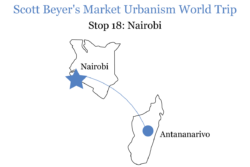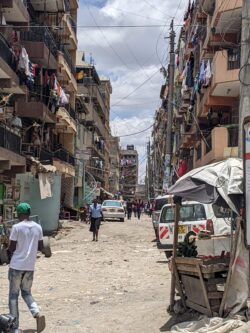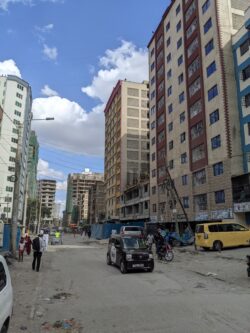The Emergent Urbanism Of Nairobi
The city’s working-class areas show the urban typologies that fill in assuming strong market demand and limited government oversight.
The theory of osmosis refers to the inevitable movement of water given the internal and external pressure around cells. Cities, namely in the 3rd World, seem also to have a certain osmotic pressure. Create an area with high economic opportunity, lower the barriers for entering it, and—like osmosis—people of lower means rush in and build societies. As the organism grows more complex, it evolves to fit new needs. This evolution has come to be known as “emergent urbanism.”
The emergent urbanism phrase is an important but lightly-covered concept in the planning discourse. Mathieu Helie, on his blog of the same name, describes it as “a guidebook on how to gradually recover [new cities] and make them as complex as the traditional cities we love, by changing one tiny detail at a time.”
As a Market Urbanist, I’m interested in how cities function under private rather than public sector control. I see overlap with emergent urbanism, since cities tend to grow iteratively when left to market forces.
African cities are case studies. Their economic order often works like this: a large facility (think a Coca-Cola bottling plant) locates in a peripheral suburban area, wanting access to cheap labor. People from across the country, namely rural peasants, flood there looking for work, building shacks around the factory. As incomes rise, they start to improve these homes. Ultimately, this market proof draws outside investors, who provide the capital to create truly standardized buildings and amenities.

 Nairobi’s eastside is an emergent urbanism shrine. It’s an industrial zone (there’s even a section there called Industrial Area) that houses plants for steel, pharmaceuticals, etc. Around it is where the organic growth pops up.
Nairobi’s eastside is an emergent urbanism shrine. It’s an industrial zone (there’s even a section there called Industrial Area) that houses plants for steel, pharmaceuticals, etc. Around it is where the organic growth pops up.
While submarkets throughout the eastside vary, it has long had many shanties, notably in the Mathare neighborhood. But the flood of migrants means that on many blocks, the shanties are an uneconomical land-use given the intense demand. So the area is now becoming redeveloped for its next iteration, a specific Nairobian vernacular.

The new structures are 5-10 stories, do not have elevators, and practically no aesthetic frills, with exposed cinderblock. Buildings go up against lot lines, butting into other buildings, except where property owners have cooperated to create alleys. Rents, according to my driver, are usually $20-60 per month depending on flat size (there is seldom online price data available for slum rentals).
Informal retail dominates the streets, as well as the ground level of these buildings and sometimes several stories up. You can buy everything from fresh fruit to household goods to goat intestines.
One neighborhood over from Mathare, called Ngara, is in an even further iteration. It’s become a hub for Somali immigrants who were driven by political strife from their homeland. They outbid Kenyans for property, forking over several million USD per acre, and construct buildings that are taller and nicer than most others on the eastside.
Further north, in Nairobi’s Zimmerman neighborhood, shanties, mid-rises, and typologies in-between mix.
On the southside, the notorious Kibera slum is earlier into this evolution. The government has tried speeding that up by building standardized public-private projects. But that hasn’t upgraded things as quickly as on the eastside, where demand is greater due to factory jobs and central proximity.
The final iteration of the eastside, assuming it happens, would be to ape the First-World-level development of westside Nairobi. That area, too, began as something much less (large single-family estates) before redeveloping into luxury condos and high-end corporate offices.
This emergent order—with an area being migrated upon, filled in, and built upwards—is a common African tale, a sort of “water is wet” commentary on the urbanization continent-wide. It happens part and parcel with absentee governance. While regulations do apply, such as building heights, enforcement is poor and can be skirted through bribes. This has caused such buildings to occasionally fall down and kill people. Other times, sewage runs downhill into streams.
On the flipside, regulation ends up being a luxury which adds expense and delays in construction without adding enough value, especially for the people living in eastside Nairobi. Without illegal housing, most people there would likely have no housing at all.
Nairobi and the larger Kenyan system is not something the U.S. should fully emulate, but there are lessons to take from this slapdash emergent slum urbanism. Many of our own development philosophies—whether coming from the government or large buildersare premised on master planning and building to a finished state. Often this means projects sit empty waiting for financing, and once done feel sterile.
Working-class neighborhoods of Nairobi, by contrast, are complex, diverse, and economically productive. Land fills up fast with makeshift settlements and, rather than creating an opportunity cost, are quickly destructible and actually spur more advanced development later. One can’t argue with the results, as Kenya’s per capita incomes have quadrupled the last 15 years, thanks in part to allowing a typology that handles its rural-to-urban migration. It’s another testament to how Third World neighborhoods that are “informal” and “illegal” and “emergent” still seem to work for many people.
All images credited to Scott Beyer and The Market Urbanist.
Catalyst articles by Scott Beyer | Full Biography and Publications
